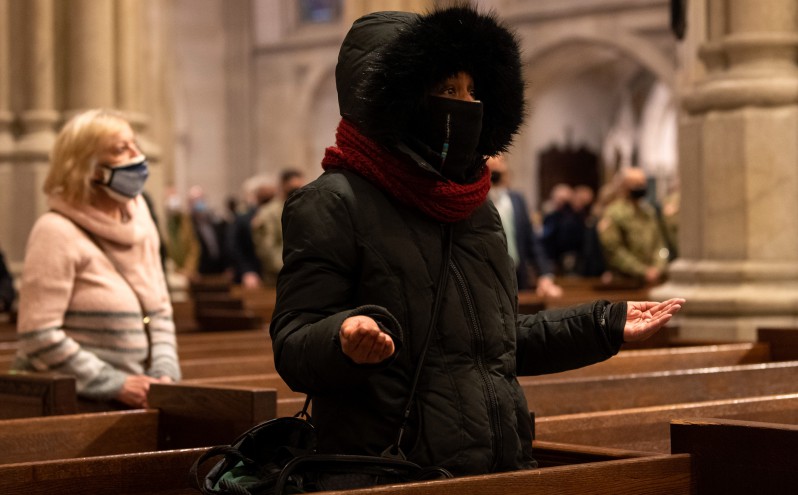
The Supreme Court blocked Governor Cuomo from enforcing COVID-19 restrictions on houses of worship.
In a clash between public health and First Amendment protections for religion, the U.S. Supreme Court sided with religious freedom.
Two religious groups—the Roman Catholic Diocese of Brooklyn and Agudath Israel of America—sued New York Governor Andrew Cuomo, challenging the constitutionality of a state order limiting attendance at religious services. Cuomo issued the order in response to an October spike in New York City’s COVID-19 cases, particularly in Orthodox Jewish neighborhoods.
In Roman Catholic Diocese v. Cuomo, the two religious groups argued that Cuomo’s order unconstitutionally discriminated against religious worship, and the Supreme Court agreed.
In its 5-4 decision, the Supreme Court found that Governor Cuomo’s order was not impartial toward religious groups because it treated houses of worship differently than secular businesses, such as garages and chemical plants. The order established color-coded zones around the city based on COVID-19 cases, with capacity in houses of worship limited to 10 people in “red zones” and to 25 people in “orange zones.” But “essential” businesses in red zones and “non-essential” businesses in orange zones faced no capacity restrictions. The Court found that this difference in treatment between the houses of worship and secular businesses demonstrated a lack of neutrality sufficient to block the regulation.
The Court’s decision—supported by Justices Amy Coney Barrett, Samuel Alito, Clarence Thomas, Neil Gorsuch, and Brett Kavanaugh—deviated from its position in two earlier cases involving similar challenges to restrictions on houses of worship in California and Nevada. In those cases, the Court did not block regulations limiting attendance.
What led to the different outcome in Roman Catholic Diocese?
Some commentators speculate that the addition of Justice Barrett made the difference. In the California and Nevada cases, Justice Ruth Bader Ginsburg provided the fifth vote needed to uphold the state regulations. But by Roman Catholic Diocese, Justice Barrett had replaced Justice Ginsburg, signaling a potential shift in the Court’s analysis of COVID-19 regulations and, perhaps, religious freedom more generally.
The Court also held the issue was still relevant even though neither house of worship was in a red or orange zone by the time the case was decided. New York argued that this fact rendered an emergency order from the Court unnecessary. The Court reasoned, however, that Cuomo could change the color-coding of the areas in the future—a point Justice Kavanaugh emphasized in his concurrence.
In another concurring opinion, Justice Gorsuch admonished the Court for its reluctance to interfere in the earlier cases, declaring one of them “mistaken from the start.” He warned that the Court’s failure to protect religious exercise from similar COVID-19 regulations suggested that the Constitution had “taken a holiday” and that this holiday could not “become a sabbatical.” Justice Gorsuch also asserted that Cuomo’s decision to deem liquor stores, but not houses of worship, essential was “exactly the kind of discrimination the First Amendment forbids.”
Chief Justice John Roberts, as well as Justices Stephen Breyer and Sonia Sotomayor, each wrote separate dissenting opinions.
Both Chief Justice Roberts and Justice Breyer reminded the Court that the plaintiff religious organizations no longer resided within red or orange zones, meaning that the parties were no longer subject to the challenged restrictions. Both justices emphasized the “extraordinary” nature of the religious groups’ relief sought and found an insufficient need to block the restrictions given the parties’ current residence in yellow zones.
Chief Justice Roberts rejected Justice Gorsuch’s suggestion that the dissenters’ position amounted to “cutting the Constitution loose during a pandemic.” The Chief Justice instead defended his colleagues’ decisions as their “best efforts to fulfill their responsibility under the Constitution.”
Taking Chief Justice Roberts’s dissent further, Justice Breyer underscored the need to defer to elected officials’ decisions about public health. He claimed that, given the deadly nature and rapid infection rate of the virus, the government must be able to react quickly to shifting conditions. To warrant an emergency order, Justice Breyer explained, the religious groups must demonstrate a more certain constitutional violation. Because the constitutionality of the regulation was unclear, Justice Breyer concluded that New York’s interest in protecting public health outweighed the need for an immediate order to halt the restrictions.
Justice Sotomayor’s dissenting opinion went the farthest in acknowledging the potentially fatal impact of the Court’s decision to block the restrictions. She noted Justice Gorsuch’s failure to explain why visiting a liquor store and attending worship services posed similar health risks and so deserved equal restrictions. She also departed from the majority’s belief that Cuomo’s order unfairly targeted houses of worship. She explained that the order expressly named houses of worship to give them preference over non-secular organizations. According to Justice Sotomayor, New York did not discriminate against the parties—it favored them.
Citing Trump v. Hawaii, in which the Court upheld former President Donald J. Trump’s notorious travel ban, Justice Sotomayor disagreed with the majority’s assessment of Cuomo’s statements. Even though Cuomo justified the regulation by referring to a spike in cases among the Orthodox Jewish community, these statements did not unilaterally prove discrimination—just as President Trump’s statements about Muslims did not prove discrimination in Trump v. Hawaii.
Justice Sotomayor emphasized that Cuomo’s order was not based on animus toward religious groups but instead was intended to save lives by limiting exposure to the virus during enclosed worship services.
The Supreme Court’s decision blocking Cuomo’s order was only temporary, and the case has returned to a lower appellate court for further consideration. Still, as that appellate court considers the case further, Cuomo will need to find other suitable restrictions if he wishes to limit attendance at houses of worship during the pandemic.
"freedom" - Google News
March 25, 2021 at 11:17AM
https://ift.tt/3sk1Duk
Religious Freedom or Pandemic Safety? - The Regulatory Review
"freedom" - Google News
https://ift.tt/2VUAlgg
https://ift.tt/2VYSiKW
Bagikan Berita Ini















0 Response to "Religious Freedom or Pandemic Safety? - The Regulatory Review"
Post a Comment